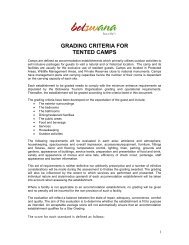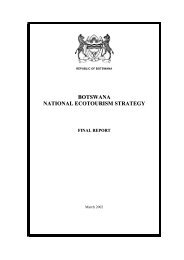COMPANION - Botswana Tourism Board
COMPANION - Botswana Tourism Board
COMPANION - Botswana Tourism Board
Create successful ePaper yourself
Turn your PDF publications into a flip-book with our unique Google optimized e-Paper software.
DOMBOSHABA<br />
An Iron Age, stone wall site<br />
dating back to 1450AD,<br />
Domboshaba (meaning ‘red<br />
rock’ in Kalanga) was occupied<br />
towards the end of the Great<br />
Zimbabwe period.<br />
Great Zimbabwe was an<br />
extensive kingdom centred<br />
at modern-day Masvingo,<br />
in present day Zimbabwe,<br />
which stretched into northern<br />
<strong>Botswana</strong>.<br />
Situated in the northeast of<br />
the country, along the Masunga-<br />
Kalamati Road, Domboshaba<br />
contains excellent examples of<br />
cement-less, stone walling and<br />
enclosures; some have been<br />
reconstructed by the National<br />
Museum archaeologists. It<br />
was one of the first National<br />
Monuments to be gazetted in<br />
the country – in 1938.<br />
Domboshaba is an open<br />
site (approximately 8 hectares<br />
in area) that includes several<br />
enclosures and the remains of<br />
partitions and bulkheads, the<br />
most spectacular of which is<br />
‘Wall 28.’ This was rebuilt by<br />
archaeologists and incorporates<br />
beautifully flowing courses<br />
of granite blocks built around<br />
existing boulders and trees.<br />
The most striking features<br />
of the walls are their evenness,<br />
despite their massive<br />
width (some are 2 metres thick)<br />
and their beautiful decorative<br />
motifs and stylistic variations, both<br />
underlining the absolute precision<br />
and aesthetic considerations with<br />
which they were built. Despite the<br />
fact that no cement was used in<br />
their construction, some walls have<br />
survived intact for centuries.<br />
Further up the hill, the floor plan<br />
of what is believed to have been a<br />
headman’s or chief’s residence can<br />
be seen. And the circular remains<br />
of houses that once dotted this<br />
community reveal earthen floors with<br />
stone edgings.<br />
23<br />
Entrance to the famous National Monument<br />
Domboshaba; Facing page: Fifteenth<br />
century stone walling at Domboshaba.<br />
Many walls have collapsed and<br />
the National Museum has prioritised<br />
this site for further restoration and<br />
development, including improved<br />
trail signage, camping and ablution<br />
facilities.<br />
An easy return day drive from<br />
Francistown that doesn’t require<br />
four-wheel drive, Domboshaba<br />
gives entrance to one of Africa’s<br />
greatest empires, and an important<br />
cultural heritage of the nation.












